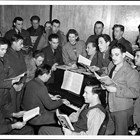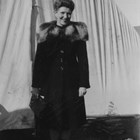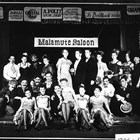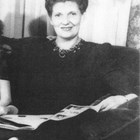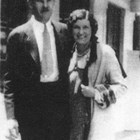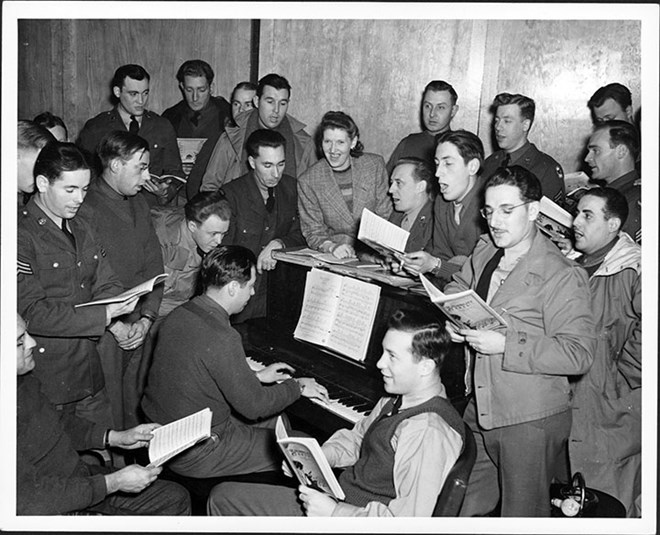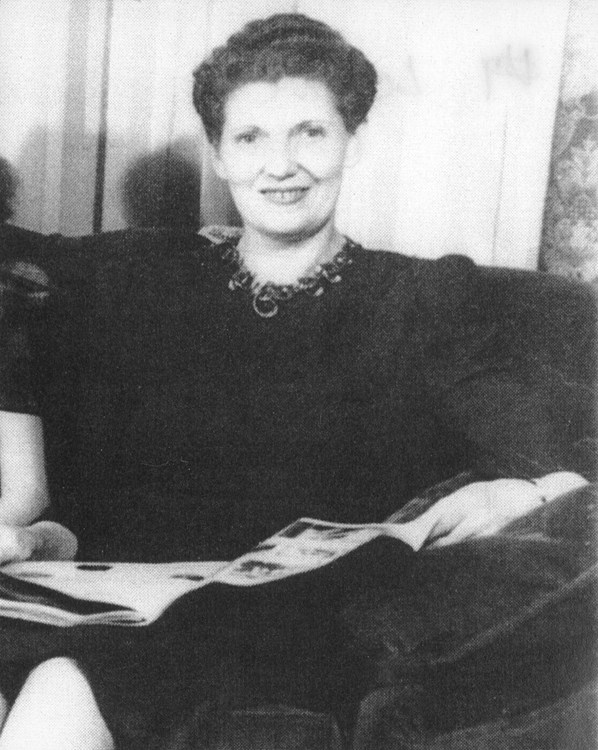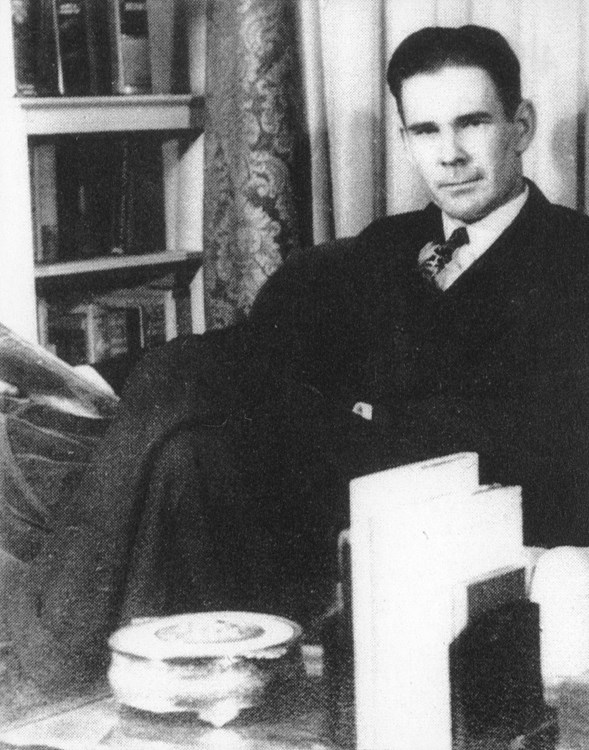Harrison, Lorene
1905-2005 | Civic and Cultural pioneer, Business Owner, and Teacher
Anne Lorene Cuthbertson Harrison was one of the most important figures in the founding and development of a number of musical, theatrical, and fashion-related organizations and activities in Anchorage, Alaska. She was the first music teacher in the Anchorage public schools and not only directed amateur shows and church choirs but instilled a desire for a higher level of performing arts.1
In Harrison’s October 22, 2005 Anchorage Daily Times obituary, Mark Baechtel gave this summary of the achievements of this pioneer cultural leader: "If there was a significant cultural event in Anchorage during the last 77 years, odds are Lorene Harrison either conceived it, planned it, taught the musicians who performed in it, founded the organization that sponsored it, raised money for it, volunteered her time to bring it off, attended it, or had a hand in its staging. She worked with nearly every musical organization in the city, including the USO during World War II, the Anchorage Concert Chorus – which she founded the year after the war ended and directed for three years – the Anchorage Opera, the Anchorage Symphony Orchestra, the Anchorage Concert Association, and many more."2
Harrison continued the pattern set by the early cultural development of Anchorage, led as early as the spring of 1915 when Alaska Engineering Commission executives brought their wives with them. Community interest in music began when the Anchorage Choral Club was organized in 1916. Through the years, a community choral project continued with slight changes in its name, such as, Choral Union of Anchorage, Anchorage Choral Society, Men’s and Women’s Glee Clubs, Anchorage Community Chorus, and the Anchorage Concert Chorus. As noted by Elvera Voth, former conductor of the Alaska Chamber Singers and artistic director of the Alaska Chamber of Music, Lorene Harrison was able to get so many projects accomplished because of her energy and enthusiasm, which sparked enthusiasm in others.3
Early Years
Anne Lorene Cuthbertson Harrison was born on March 7, 1905, in Sheridan Township, Crawford County, Kansas.4 She was the youngest of three children born to Mathew M. Cuthbertson (1853-1947) and Margaret Eleanor Dunlap Cuthbertson (1861-1950). She always used only Lorene as a first name.
Less than a year after her birth, her father, Matthew, sold the family farm and moved to the small college town of Sterling, Kansas, with a population of about 3,000 in the center of Kansas, where he purchased a soft drink bottling plant, the Rice County Bottling Works.5 Lorene grew up in Sterling, where she had all her public schooling, graduating from high school in the spring of 1922.6
Music was always in the center of the family’s life. Lorene’s mother, Margaret, played the piano and her father, Matthew, played the violin. Lorene’s formal music lessons began in the third grade, when she started to take piano lessons, but she loved to sing. Lorene’s voice lessons began when she was fourteen and continued through her college years. When she was a high school senior, her music teacher sent her to the state music competition, where she took third place. Her high school years were focused on musical activities, as she was in all of the musical productions. She was captain of the girls’ basketball team, and participated on the debate team.7
Teaching Career
Cuthbertson attended Sterling College, Sterling, Kansas, where she earned a Bachelor of Arts degree in home economics in 1928 and, earlier, a teaching certificate. She was a soprano soloist with the glee club and the piano accompanist for the Sterling College orchestra. After completing her freshman and sophomore years and receiving a teaching certificate, she interrupted her education by applying for a teaching position in Fromberg, Montana, a small sugar beet growing community about forty miles from Billings. She taught music for all grades, kindergarten through high school, and some junior high subjects. The small Montana town had never had music in the school before Culbertson’s arrival. While teaching there in 1925 and 1926, she organized a girl’s glee club that won the Eastern Montana Music Meet and then finished in second place in the entire state. She remembered that Fromberg “just went crazy” about the choir’s success. In addition to her teaching responsibilities, she directed a church choir and coached the girls’ basketball team in her second year. After the team went on to win the county championship, once again “the town went wild.”8
After returning to Sterling in 1927, Cuthbertson finished her B.A. degree in the spring of 1928. She worked the summers of 1926 and 1928 as a “pillow puncher” (a “tent girl” taking care of the cabins) at Yellowstone Canyon Camp, one of four camps at Yellowstone National Park. Besides her regular duties, she sang, played the piano, and conducted other musicians to entertain the guests in the evening.9
In 1928, Cuthbertson was hired as a teacher of home economics and music at Anchorage High School. It was while she was completing her course work during her senior year at Sterling College that she had been given the assignment of writing about a different ethnic group. She chose the “Alaska Eskimo” as her topic. Since there was little information about Alaska in the college’s library, she found herself getting out an atlas identifying the larger towns in Alaska—Ketchikan, Anchorage, Juneau, and Fairbanks. She wrote letters, addressed to the superintendent of schools in each of these larger Alaskan cities, to ask for information for her research project.
“I thought I wanted to teach my way around the world.” Lorene had begun a correspondence with the Ketchikan school superintendent, Mr. Burdick, while doing her college project about Eskimo families and he suggested she try getting a teaching job in Alaska. Intrigued, she did, and learned that the superintendent of schools in Anchorage, Cecil Sly, was looking for someone to teach home economics and music in the local high school, a position that seemed tailor-made for her abilities. The job paid $180 a month, compared to the $60 per month that her friends were paid as teachers in Kansas. She got the job and then informed her family. Interviewed by historian Stephen Haycox for the Anchorage Pioneers Oral History Project, Harrison said that she was full of excitement and then informed her parents. She sent them a telegram from Yellowstone with this news. Harrison said: “My mother could not understand” why she wanted to go teach in Alaska. Her parents would have been more accepting if she were to have become a Christian missionary to a foreign country, but not a teacher in Alaska.10
In the late summer of 1928, Culbertson boarded a train from Yellowstone National Park to Seattle, took the steamer S.S. Yukon to Seward, and caught the train into Anchorage. When the train pulled in, many townspeople met the train, partly to greet returning friends and family but also to see who was newly arrived. She found Anchorage to be “a rough and tumble town” of about 2,500.11 Her first impressions, fresh and accurate, were recorded in the Sterling, Kansas Bulletin, in her article dated April 25, 1929, eight months after her arrival:
"We have found Anchorage by far the best planned and laid-out town that we saw since leaving the States. It is built on a huge plateau with Cook’s Inlet on the north and west, and the mountains averaging about 12 miles away on the east and south. There are many lovely hikes one can take in these mountains. It is the Chugach Range. . . . We have the best hospital in Western Alaska here, a dental clinic, a large number of good cafes, modern refrigerated meat markets, dandy groceries, a Rexall Drug Store besides several privately owned ones, fur shops, three photograph galleries, novelty shops, jewelry stores, magazine stands, and, in fact, I can think of nothing we lack. We even get the popular records and sheet music from Seattle."12
Cuthbertson was the town’s first public school music teacher, and besides music and home economics, taught general science and commercial geography. Immediately, she began to organize the students into plays and choruses. She produced and directed the first production for the high school choral group, Anchorage’s first operetta, Miss Cherry Blossom. On Friday evening, December 14, 1928, the Japanese operetta in three acts was presented in full costume at the Empress Theatre. In a lengthy review article in the Anchorage Daily Times, it was proclaimed in the paper’s headlines, “Student Players Delight Audience in Musical Show,” followed by the subheading “Miss Cherry Blossom Scored Big Hit at Empress Last Evening.” The review continued: "The Anchorage public is indebted to the students of the high school for an evening of rare enjoyment, the operetta, Miss Cherry Blossom, which was presented at the Empress Theatre last night under the direction of Miss Lorene Cuthbertson, having proved one of the most pleasing entertainments ever staged in Anchorage."13
The review was full of praise for the specially designed oriental settings, the dancing, splendid costuming, orchestra direction, and piano playing. The show was a complete success and “everyone in town came.” That evening, she met her future husband, Jack F. Harrison, a big game guide.14
Return to Anchorage in 1934
In July 1929, Cuthbertson briefly left Alaska to fulfill her promise to her parents to return to teach in Kansas. Jack Harrison followed her outside for a visit on Christmas, 1929. On July 3, 1930, she and Jack were married at Grand Lake, in Rocky Mountain National Park, near Estes Park, Colorado. The couple remained in Denver where Jack was studying for a degree in chemical engineering. In 1932 the couple had their first daughter, Margaret Lee, known as “Pegge.” The newly married couple bought a house in Colorado, but financially tough times caught up with them, they could not afford to make the payments, and they lost the house. In 1934, they returned to Anchorage, believing that their economic chances were better there.
Jack Harrison got a job with the Alaska Railroad as a locomotive engineer, and remained with the railroad until immediately after World War II.15 In 1953, he became the vice president of Basic Building Products, Inc., a small, modern brick plant located on the Ship Creek flats near the Anchorage Sand and Gravel Company, Inc., a mining and hauling business. The president of Basic Building Products, Inc. was Arthur “Art” Waldron, the founder of Anchorage Sand and Gravel Company, Inc. Later, Harrison became vice-president of Anchorage Sand and Gravel Company, Inc. He was the owner of the Cinder Concrete Products Company. He served on the board of trustees of the First Presbyterian Church, and was involved in volunteer work with the Boy Scouts. Lorene and Jack Harrison were divorced in 1963. Jack Harrison died in 1968.16
Married women with children at that time, 1934, generally were not allowed to teach in public schools, so Lorene’s going back to her old job was not realistic. Harrison later said: “Nobody hired married teachers.” To help the family financially, she did substitute teaching, began giving voice and piano lessons, and sang for weddings and funerals. The couple’s second daughter, Carol Anne, was born shortly after the Harrisons returned to Anchorage.17
Harrison’s talent for singing and organizing was recognized shortly after the Harrisons returned to Anchorage. In 1934, she was asked to take over direction of the First Presbyterian Church Choir (a position she would hold for almost thirty years). When she began to direct, there were six or eight choir members but, as membership grew, the choir occasionally outnumbered the congregation.
Beyond her responsibilities as director of the First Presbyterian Church Choir, Harrison found a large pool of untapped and unorganized musical talent in the local community. She first organized the Women’s Community Glee Club in 1935 and, a year later, a Men’s Community Glee Club. The two clubs combined to give Christmas music concerts at the Elks Club beginning in 1936. That same year, she was asked to provide musical entertainment for the winter carnival that became in later years the Fur Rendezvous. She organized a singing fur fashion show at the Elks Hall for which Jeanne Laurence18 painted a large blue, iridescent, icy looking background painting—mountains, cabins, and northern lights. It was the first of over five hundred fashion shows that she would coordinate and organize.19 In October 1938, the Presbyterian Church Choir sponsored the appearance of Margaret Bowen, the Seattle soprano, the first outside artist to perform in Anchorage.20
In 1924, radio station KFQD began its operations in Anchorage. In its early years, this station only broadcast in the evenings, and local people helped provide programming by singing, playing instruments, or doing humorous skits. During the mid-1930s, Harrison was recruited to sing once a week on the radio for a program supported by Hewitt’s Drugstore. She teamed with Frank Howard for duets while Nel Hewitt played the piano.21
Harrison was also involved in arranging music. In 1941, she composed the four-part vocal arrangement of Alaska’s beloved state song, the Alaska Flag Song. In 1927, the flag was designed by Benny Benson, who became one of her friends. Inspired by the flag’s design, Marie Drake, the Territorial Commissioner of Education, wrote a poem titled Alaska’s Flag in 1935. Drake’s words were put to music in 1938 by Elinor Dusenbury, a public school choir director in Nebraska, who was homesick after she had left Alaska in 1936. Drake’s musical score, with Harrison’s four-part arrangement of the music, made its debut at the 1941 Fur Rendezvous celebration, at the outdoor coronation of the Fur Rendezvous queen by Brigadier General Simon Bolivar Buckner Jr., commanding general of the Alaska Defense Command.22
World War II
During World War II, Harrison was the music director of the USO in Anchorage. In September 1941, Anchorage’s first USO building, located in a large log cabin at the corner of 5th Avenue and G Street, was opened. Local businessmen, civilian and military personnel, and a dedicated staff provided a welcome place for military service members and their guests, and offered recreational activities, entertainment, socializing, and educational and spiritual services. In February 1942, a larger, better equipped building that was capable of holding five hundred people was completed on a site leased from the Anchorage Post of the American Legion.23
As music director of the USO, Harrison organized “community sings,” gave singing and piano lessons, and, working with the local community, produced theatrical productions, such as Bonanza Days in 1942 and 1943, since large community activities like the Fur Rendezvous celebrations were temporarily suspended during the war.24
When Hollywood stars Ginger Rogers and Hedda Hopper came to the Anchorage USO to entertain in 1942, Harrison presented them with one of her hand-made, ornate hats. After school, daughters Pegge and Carol Anne would go to the USO where the soldiers doted on them. To show their family’s hospitality, the Harrisons, like many Anchorage families, invited military servicemen to dinners at their home. Lorene remembered that she was constantly baking to bring food to the USO. “I think I baked a cake every day of the war” for some G.I.’s birthday at the USO. Years later, Lorene commented that the whirlwind of activity that was her life during World War II were some of the happiest years of her life. “I felt that I was accomplishing something important – that my work was needed.”25
When Anchorage became overrun with newcomers who could not find a place to live, Harrison took on the role of finding temporary housing or lodging in private homes or other suitable accommodations. In 1944, Charlie Wallulus, president of the Lions Club, proposed that she become the director of the Anchorage Emergency Housing Bureau. During World War II, the population boom created an immediate housing shortage. Anchorage’s population more than doubled from about 4,000 in 1940 to 9,000 in about mid-1942, and came out of the war as a city with a civilian population of 12,000.26 This influx put a tremendous strain on the city’s already inadequate social services, especially housing for families, as well as schools, hospitals, and local government. People lived in shacks, tents, hotel rooms, or were reduced to renting bed space for twelve hours or even walking the streets for lack of other alternative housing. Harrison, because she knew everyone in town, helped locate spare beds and temporary and permanent housing. She later remembered that she “enjoyed my duties tremendously, but it was the hardest work of my life,” due to the long hours. In 1945, she helped 2,100 people find homes in Anchorage.27 In March 1946, Harrison, with the support of local merchants and organizations, established the Anchorage Welcoming Service, which had the mission to provide support and assistance to newcomers.28
Women’s Business Owner
In 1948, Harrison began a millinery shop called the Hat Box in downtown Anchorage (429 G Street), which sold fashionable women’s hats. She provided the initial stock by spending a month sewing forty hats. After advertising her new store, it opened on August 17, 1948 and by 4:00 p.m., she did not have a single hat left in stock. She sat up all night making more hats, and contacted a New York firm to order some “ready-mades.” From that time, her business continued in various forms through moves to larger locations for thirty years. Of her business, Lorene said: “I loved it, but I got a bull by the tail and couldn’t let loose.” Lorene enjoyed working with people, and she enjoyed the buying trips she made to New York and even Paris to buy stock. When she was in New York for the Hat Box, she would meet performing artists who might be invited to Alaska. Her last business venture was called Lorene’s, which was located in the University Mall in midtown Anchorage. The shop featured an artistic collection of hats but expanded into a bridal consultation and fine dress shop. In 1978, she sold the business, at age seventy-two.29
Post-War Cultural Activities (1946-1970)
After the end of World War II, Harrison became closely involved in the development of several musical and theatrical organizations. Interest in amateur theater lagged during the war years, but was revived in 1946 by Frank Brink, who later became the head of the Anchorage Community College’s department of speech and drama. Near the end of World War II, the Anchorage Little Theatre was formed to provide locally produced theatrical productions. The group incorporated as the Anchorage Little Theatre, and Harrison was a member of the first board of directors. Their first production was Ladies in Retirement, and the next was Our Town. Among the newly organized group’s most outstanding successes was Arctic Summertime performed in the summers of 1949 and 1951 for week-long runs and with Marita Farrel, Metropolitan Opera star, as conductor. The Anchorage Little Theatre sponsored the Anchorage Symphony and the Anchorage Community Chorus.30 In 1947, the Anchorage Community Chorus (later known as the Anchorage Concert Chorus) was founded by Harrison.31
When the members of the Presbyterian Church Choir decided to sing Handel’s Messiah, Harrison recruited additional choral members from other Anchorage churches and the local community. Musicians were recruited for this occasion, calling themselves the Anchorage Little Symphony, and the Anchorage Little Theatre provided financial backing. When their concert was performed in March 1947, it was a resounding success. It was considered as the first production of the Anchorage Community Chorus.32
In 1946, Harrison became chairperson of a Little Theater committee to invite outside musical artists to Anchorage to give concerts. The first artist, pianist Grant Johannesen, played in March 1947. Buoyed by the success of this concert, a succession of singers and musicians followed. Maxim Schapiro, a Russian born pianist, came several times and helped promote Alaska to fellow artists. Schapiro called his program The Alaska Music Trail.
In 1950, Harrison organized the Anchorage Concert Association, to initially sponsor the Anchorage portion of The Alaska Music Trail, and she became its first president. The organization worked closely with Music Trails, which brought performing artists to seventeen cities in Alaska and Canada. She often entertained the visiting artists, toured them around Anchorage, and hosted them at her home at 10th and N Street, overlooking the Delaney Park Strip. Among the artists she impressed with her hospitality were Leonard Bernstein, Eugene Ormandy, Van Cliburn, Marilyn Horn, Fred Waring, and Isaac Stern. “I will tell you every artist that has ever come here has wanted to come back because we really gave them the red carpet treatment.” One of the vocal artists, Marita Farell, so enjoyed her visits that she moved from New York City to Anchorage and founded the Anchorage Civic Opera in 1962.33 Harrison served on the board of directors of the Anchorage Civic Opera. In 1955, she joined the board of the Alaska Festival of Music. The Anchorage Concert Association remains an important force in promoting the arts in the community.34
From 1954 to 1958, Harrison was the host of a local women’s television program, Lorene’s Scrapbook on KFIA-TV, Channel 2, affiliated with both ABC and CBS. The show aired five days a week, live, initially for forty-five minutes, later for an hour. She interviewed guests, cooked and sewed, discussed community events, sang, booked guests, and sold her own advertising. One of the high points was making a guest appearance in 1957 on Arlene Francis’s nationally televised Home Show, which appeared on NBC. Alaska was struggling for recognition as a state, and Lorene’s appearance was a good opportunity for her to “wave the flag for Statehood.” The results of her appearance on national television generated considerable interest, and the Anchorage Chamber of Commerce received bags of mail inquiring about Anchorage and Alaska. In May 1955, Harrison was given an award for her women’s TV show at the third annual Alaska Press Club award dinner in Anchorage. She finally left television because of the press of business at the Hat Box. 35
Before Alaska became a state, it needed a representative for the Miss America Pageant. In 1962, Harrison became the state chaperone for the Miss Alaska Pageant and continued in this capacity until 1970. She shared her knowledge of good grooming, hair styling, and worked on their social graces to help polish their talent. All of these Miss Alaskans lived at her home for the entire summer to get ready for the national competition. When Colleen Pettit was named Miss Alaska Centennial in 1967, as part of the celebration to commemorate the one hundredth anniversary of the purchase of Alaska from Russia, Harrison traveled as her chaperone from coast-to-coast, making appearances.36
Final Decades
Beginning in 1969, when Harrison was in her mid-60s, she helped organize the Anchorage Arts Council, serving as vice-president from 1970-1972. She continued to hold membership and sometimes board positions with Anchorage Community Choir, Little Theatre, and was president of the Anchorage Concert Association in 1974. She was an active member of Beta Sigma Phi sorority, which she helped organize in 1942. She was the Southcentral Alaska campaign director for the March of Dimes, 1978-1979.37
In November 1990, Harrison returned to the First Presbyterian Church as guest conductor for the church’s 75th anniversary celebration. Under her guidance, she conducted two Sunday services, with one of her old choir compatriots, soprano Kathryn Chenoweth, saying that the Harrison she saw “was the same old Lorene. She hadn’t forgotten a thing.”38
Harrison received numerous awards during her lifetime. As early as 1951, she was recognized for her achievements when the Beta Sigma Phi sorority named her as Anchorage’s “First Lady of the Year.” In 1954, the Anchorage Woman’s Club selected her as nominee for Alaska Territorial Mother of the Year, an annual contest sponsored nationally by the Golden Rule Foundation.39 The Anchorage Concert Association elected her as president for their Silver Anniversary in 1974. In 1978, she became the third recipient of Sterling College’s Distinguished Service Award. Mayor George Sullivan declared March 19, 1981 as Lorene Harrison Day in Anchorage. That same year, she received the Community Service Award from the International Festivals and Northwest Festivals Association. In 1987, she received the Governor’s Award for the Arts. In 1988, the entrance to the Evangeline Atwood Concert Hall of the Alaska Center for the Performing Arts was named the Lorene Harrison Lobby. She was honored as Alaskan of the Year for 1992.40 In 2001, she was the winner of the first Lorene Harrison Award for Lifetime Achievement, given by the Municipality of Anchorage’s Arts Advisory Commission, at the Mayor’s Awards for the Arts.41
Her 100th birthday was celebrated with a gala concert at the Alaska Center for the Performing Arts, with Lorene Harrison and 1,700 others in attendance, “a tribute to all that she has done.”42 She received the Meritorious Service Award from the University of Alaska Anchorage on her 100th birthday.
One of her friends, Jerry Connor, wrote: “Her record of creative achievement seems beyond the limits of any one individual.” Robert Atwood, longtime editor of the Anchorage Times wrote a column in his “Between Us” series that “It must take a dozen or more [people] to carry on the programs and organizations left in the wake of Lorene’s path through history.” Anchorage Concert Association executive director Ira Perman put it simply: Lorene Harrison was “the founding mother of the arts in Anchorage.”43
On October 21, 2005, Lorene Harrison died at her residence at the Anchorage Pioneers’ Home. She is buried at the Anchorage Memorial Park Cemetery. She was survived by her daughters, Carol Ann Dodd and Margaret Lee ("Pegge") Vielbig; sons-in-law, Robert Dodd and Joe Viebig; six grandchildren; seven great-grandchildren; and other relatives and friends.
Lorene Harrison was posthumously inducted into the Alaska Women's Hall of Fame, Class of 2009. As quoted by the Alaska Women's Hall of Fame: "Throughout her life she appeared to have the philosophy "if Anchorage doesn't have, create it yourself" (http://alaskawomenshalloffame.org/alumnae/class-of-2009).
Endnotes
1. Evangeline Atwood, Anchorage: Star of the North (Tulsa, OK: Continental Heritage Press, Inc., 1982), 75; and John Strohmeyer, Historic Anchorage: An Illustrated History (.San Antonio, TX: Historical Publishing Network for the Anchorage Museum Association, 2001), 60-61.
2. Mark Baechtel, “A Pioneering Muse to the very end – Anchorage Arts Patron and Musician Dies at 100, Lorene Harrison: 1905-2005,” Anchorage Daily News, October 22, 2005, B-1.
3. “Musical Pioneer Performs Encore,” Anchorage Daily News, November 23, 1990, E-1.
4. Entry for [Anne Lorene] Cuthbertson, Kansas, Births and Christenings Index, 1885-1911 [database on-line], http://ancestry.com (accessed November 22, 2015).
5. Dianne Barske, Mostly Music: The Story of Lorene C. Harrison, Alaska’s Cultural Pioneer (Anchorage: Publications Consultants, 1999), 17-18.
6. Ibid., 45.
7. Ibid., 23, and 29-31.
8. Ibid., 31-32, and 39.
9. Transcript, “Lorene Cuthbertson Harrison,” November 11, 1993, 1-8, File: 9; Stephen Haycox and Maureen Cowles, interviewers, Anchorage Pioneers Oral History Project, Oral History Transcripts, 1992-1995 (HMC-0466), Box 1, Archives and Special Collections, Consortium Library, University of Alaska Anchorage; Transcript, “Harrison, Lorene,”August 26, 1980, 1-6, File: 28; Maria Brooks, principal interviewer; Alaska Women’s Oral History Project Records, 1965-1982 (HMC-0037),Archives and Special Collections, Consortium Library, University of Alaska, Anchorage, and Dianne Barske, Mostly Music: The Story of Lorene C. Harrison, Alaska’s Cultural Pioneer, 17-18 and 31-43.
10. Stephen Haycox and Maureen Cowles, Transcript, “Lorene Cuthbertson Harrison,” 7-9; Anchorage Pioneers Oral History Project, Oral History Transcripts, 1992-1995 (HMC-0466); Maria Brooks, Transcript, “Harrison, Lorene,” 2-7; Alaska Women’s Oral History Project Records, 1965-1982 (HMC-0037); and Dianne Barske, Mostly Music: The Story of Lorene C. Harrison, 45-47.
11. Entry for Lorene Cuthbertson-Harrison, Fond Memories of Anchorage Pioneers (Anchorage: Pioneers of Alaska, Igloo 15, Auxiliary 4, 2002), 53.
12. Dianne Barske, Mostly Music: The Story of Lorene C. Harrison, 54-55.
13. Ibid., 63.
14. Stephen Haycox and Maureen Cowles, Transcript, “Lorene Cuthbertson Harrison,” 9-11 and 17, Anchorage Pioneers Oral History Project, Oral History Transcripts, 1992-1995 (HMC-0466); Maria Brooks, Transcript, “Harrison, Lorene,” 8-11, Alaska Women’s Oral History Project Records, 1992-1995 (HMC-0037); and Dianne Barske, Mostly Music: The Story of Lorene C. Harrison, 53-54, 61-62 and 78.
15. Stephen Haycox and Maureen Cowles, Transcript, “Lorene Cuthbertson Harrison,” 9-13, Anchorage Pioneers Oral History Project, Oral History Transcripts, 1992-1995 (HMC-0466); Maria Brooks, Transcript, “Harrison, Lorene,” 12-14, Alaska Women’s Oral History Project, Records, 1965-1982 (HMC-0037); and Dianne Barske, Mostly Music: The Story of Lorene C. Harrison, 68-71.
16. “Anchorage to Get New Industry; Brick Making Plant Being Built,” Fairbanks Daily News-Miner, October 5, 1953, 10, http://newspapers.com (accessed November 27, 2015); Anchorage Sand and Gravel Company, Inc., “Part 1: The Waldron Family,” http://www.anchsand.com/default.aspx?tabid=125 (accessed November 25, 2015); Stephen Haycox and Maureen Cowles, Transcript, “Lorene Cuthbertson Harrison,” 22-24, Anchorage Pioneers Oral History Project, Oral History Transcripts, 1992-1995 (HMC-0466); Dianne Barske, Mostly Music: The Story of Lorene C. Harrison, 136; “Anchorage Pioneer Jack Harrison Dies,” [Anchorage Daily News?], File: “Jack Harrison,” Bagoy Family Pioneer Files, Box 3, Atwood Resource Center, Anchorage Museum at Rasmuson Center, Anchorage, AK; and “Rosary Scheduled for Harrison,” Anchorage Daily Times, April 18, 1968, 2.
17. Stephen Haycox and Maureen Cowles, Transcript, “Lorene Cuthbertson Harrison,” 14-15 and 41, Anchorage Pioneers Oral History Project, Oral History Transcripts, 1992-1995 (HMC-0466); Maria Brooks, Transcript, “Harrison, Lorene,” 13-16, Alaska Women’s Oral History Project, Records, 1965-1982 (HMC-0037); and Dianne Barske, Mostly Music: The Story of Lorene C. Harrison, 73-76.
18. Jeanne Kunath Holeman Laurence was a French painter and the second wife of Sydney Laurence (1865-1940), the foremost painter of Alaskan landscapes during the first three decades of the twentieth century.
19. H. Wendy Jones, Alaska’s Dynamic Women: 200 Years of Alaskan Women, Volume II (Newport Beach, CA: Detail Quality Printing, Inc., 1977), 123.
20. Dianne Barske, Mostly Music: The Story of Lorene C. Harrison, 78-81; and Stephen Haycox and Maureen Cowles, Transcript, “Lorene Cuthbertson Harrison,” 18-21, Anchorage Pioneers Oral History Project, Oral History Transcripts, 1992-1995 (HMC-0466).
21. Stephen Haycox and Maureen Cowles, Transcript, “Lorene Cuthbertson Harrison,” 18, Anchorage Pioneers Oral History Project, Oral History Transcripts, 1992-1995 (HMC-0466); Maria Brooks Transcript, “Harrison, Lorene,” 17, Alaska Women’s Oral History Project, Records, 1965-1982 (HMC-0037); and Mark Baechtel, “A Pioneering Muse to the very end – Anchorage Arts Patron and Musician Dies at 100, Lorene Harrison: 1905-2005,” Anchorage Daily News, October 22, 2005, B-1.
22. Dianne Barske, Mostly Music: The Story of Lorene C. Harrison, 85-86.
23. “Anchorage Bows Out,” Forty-Ninth Star (Anchorage), December 28, 1947; and “The Friendly Log Cabin: The USO in Anchorage, 1941-1945,” November 2000-March 2001, Archives and Special Collections, Consortium Library, University of Alaska Anchorage; online exhibit, http://consortiumlibrary.org/archives/Photographs/PhotoExhibits/USOin%20Anchorage.html (accessed November 26, 2015).
24. Dianne Barske, Mostly Music: The Story of Lorene C. Harrison, 101-102.
25. Stephen Haycox and Maureen Cowles, Transcript, “Lorene Cuthbertson Harrison,” 30, Anchorage Pioneers Oral History Project, Oral History Transcripts, 1992-1995 (HMC-0466); and Dianne Barske, Mostly Music: The Story of Lorene C. Harrison, 91-105.
26. Elizabeth Tower, Anchorage: From Its Humble Beginnings as a Railroad Construction Camp (Fairbanks: Epicenter Press, 1999), 83; Evangeline Atwood, Anchorage: All-America City (Portland, OR: Binfords & Mort, 1957), 42; and Pat Lawler, “Taking the Territory by Storm: Buckner and his Boys Invade Alaska!,” Alaska Journal: A 1981 Collection (Anchorage: Alaska Northwest Publishing Company, 1981), 96.
27. Maria Brooks, Transcript, “Harrison, Lorene,” 20, Alaska Women’s Oral History Project, Records, 1965-1982 (HMC-0037); and Dianne Barske, Mostly Music: The Story of Lorene C. Harrison, 107-108.
28. Dianne Barske, Mostly Music: The Story of Lorene C. Harrison, 109.
29. Maria Brooks, Transcript, “Harrison, Lorene,” 22, Alaska Women’s Oral History Project, Records, 1965-1982 (HMC-0037); and Dianne Barske, Mostly Music: The Story of Lorene C. Harrison, 110-112.
30. Evangeline Atwood, Anchorage: All-America City, 95-96.
31. Anchorage Concert Chorus: Our History; http://www.anchorageconcertchorus.org/who-we-are.html (accessed November 25, 2015).
32. Dianne Barske, Mostly Music: The Story of Lorene C. Harrison, 112-116.
33. “Guide to the Anchorage Civic Opera Association Records, 1962-1984 (HMC-0049), Archives and Special Collections, Consortium Library, University of Alaska Anchorage, https://consortiumlibrary.org/archives/FindingAids/hmc-0049.html (accessed November 22, 2015).
34. Maria Brooks Transcript, “Harrison, Lorene,” 20, Alaska Women’s Oral History Project, Records, 1965-1982 (HMC-0037); and Dianne Barske, Mostly Music: The Story of Lorene C. Harrison, 115-132.
35. Maria Brooks, Transcript, “Harrison, Lorene,” 24, Alaska Women’s Oral History Project, Records, 1965-1982 (HMC-0037); and Dianne Barske, Mostly Music: The Story of Lorene C. Harrison,136-142.
36. Dianne Barske, Mostly Music: The Story of Lorene C. Harrison, 153-163.
37. Dianne Barske, Mostly Music: The Story of Lorene C. Harrison, 125-127 and 153-163.
38. “Musical Pioneer Performs Encore,” Anchorage Daily News, November 23, 1990, E-1.
39. Dianne Barske, Mostly Music: The Story of Lorene C. Harrison, 133-134.
40. Ibid., 198, 200-201, 221,234 and 236.
41. “Artistic Merit – City Commission Honors Five who made a Difference,” Anchorage Daily News, April 29, 2001, D-5.
42. “Obituaries—Lorene Harrison, 100,” Anchorage Daily News, October 27, 2005, B-9.
43. Dianne Barske, Mostly Music: The Story of Lorene C. Harrison, 184, 199 and 208.
Sources
This biographical sketch of Lorene Harrison is based on her biography, Mostly Music: The Story of Lorene C. Harrison, Alaska’s Cultural Pioneer, by Dianne Barske (Anchorage: Publications Consultants, 1999).
This entry originally appeared in John Bagoy’s Legends & Legacies, Anchorage, 1910-1935 (Anchorage: Publications Consultants, 2001), 231-232. See also Jack Harrison file, Bagoy Family Pioneer Files (2004.11), Box 3, Atwood Resource Center, Anchorage Museum at Rasmuson Center, Anchorage, AK. Note: edited, revised, and substantially expanded by Walter Van Horn and Bruce Parham, November 7, 2015.
Preferred citation: Bruce Parham and Walter Van Horn, “Harrison, Lorene,” Cook Inlet Historical Society, Legends & Legacies, Anchorage, 1910-1940, http://www.alaskahistory.org.
Major support for Legends & Legacies, Anchorage, 1910-1940, provided by: Anchorage Museum at Rasmuson Center, Atwood Foundation, Cook Inlet Historical Society, and the Rasmuson Foundation. This educational resource is provided by the Cook Inlet Historical Society, a 501 (c) (3) tax-exempt association. Contact us at the Cook Inlet Historical Society, by mail at Cook Inlet Historical Society, Anchorage Museum at Rasmuson Center, 625 C Street, Anchorage, AK 99501 or through the Cook Inlet Historical Society website, www.cookinlethistory.org.
